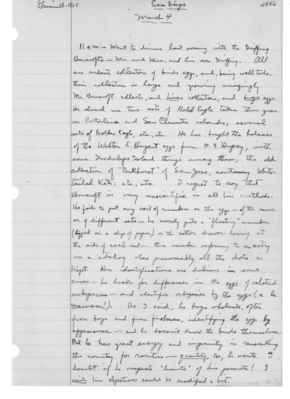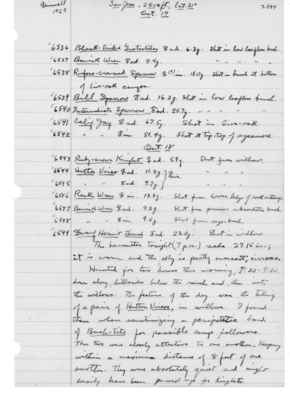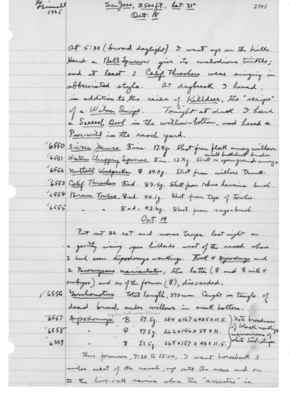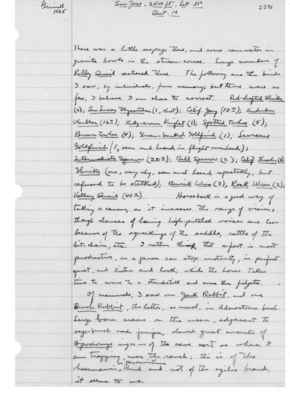Pages That Mention San Jose
1925: Joseph Grinnell's field notes
S1 Page 7
Collector: Grinnell-1925 Location: San Diego Date: June 17, 1925 Page Number: 2456
11 a.m. - Went to dinner last evening with the Griffing Bancrofts - Mr. and Mrs., and his son Griffing. All are ardent collectors of birds eggs, and, being well-to-do, their collection is large and growing amazingly. Mr. Bancroft collects, and hires collectors, and buys eggs. He showed me two each of Bald Eagle taken this year on Catalina and San Clemente islands, several sets of Golden Eagle, etc., etc. He has bought the balance of the Walter E. Bryant eggs from H. F. Duprey, with some Guadalupe Island things among them; the old collection of "Parkhurst" of San Jose, containing White Tailed Kites, etc., etc. I regret to say that Bancroft is very unscientific in all his methods: He fails to put any sort of numbers on the eggs - of the same or of different sets - he merely puts a "floating" number (tagged on a slip of paper) on the cotton drawer-lining at the side of each set - the number referring to an entry in a catalog where presumably all the data is kept. His identifications are dubious in some cases - he looks for differences in the eggs of related subspecies - and identifies subspecies by the eggs (a la Dawson!). As I said, he buys wholesale, often from boys and from fishermen, identifying the eggs by appearance - and he doesn't know the birds themselves. But he has great energy and ingenuity in ransacking the country for rarities - quantity, too, he wants. I doubt if he respects 'limits' of his permits! I wish his objectives could be modified a bit.
S3 Page 51
Collector: Grinnell - 1925 Location: San Jose, 2500 ft., Lat. 31 degrees Date: Oct. 17 Page Number: 2594
6536 Black-Tailed Gnatcatcher (female sign) ad. 6.3g. Shot in low leafless bush. 6537 Bewick Wren (male sign) ad. 8.4.g. 6538 Rufous-crowned Sparrow (male sign)(?) im. 18.0g. Shot in bush at bottom of Live-oak canyon. 6539 Bell Sparrow (male sign) ad. 16.2g. Shot in low leafless brush. 6540 Intermediate Sparrow (male sign) ad. 25.7. Shot in low leafless brush. 6541 Calif. Jay (female sign) ad. 67.5g. Shot in live-oak. 6542 “ “ (male sign) im. 81.4 g. Shot at tip-top of sycamore.
Oct. 18 6543 Ruby-crown Kinglet (female sign) ad. 5.9g. Shot from willow. 6544 Hutton's Vireo (female sign) ad. 11.2g. } Pair “ “ “ 6545 “ “ (male sign) ad. 9.7 g. } Pair “ “ “ 6546 Rock Wren (female sign) im. 13.8g. Shot from lower ledge of rock outcrop. 6547 Bewick Wren (female sign) ad. 9.2g. Shot from prunus subcordata bush. 6548 “ “ (male sign) im. 9.5g. Shot from sage-bush. 6549 Dwarf Hermit Thrush (male sign) ad. 23.0g. Shot in willow.
The barometer tonight (7 p.m.) reads 27.15 in.; it is warm and the sky is partly overcast, cirrous.
Hunted for two hours this morning, 7:30-9:30, down along hillsides below the ranch and then into the willows. The feature of the day was the taking of a pair of Hutton's Vireo, in willows. I found them when scrutinizing a peripatetic band of Bush-tits for possible camp followers. The two were closely attentive to one another, keeping within a maximum distance of 8 feet of one another. They were absolutely quiet and might easily have been passed up for Kinglets.
S3 Page 52
Collector: Grinnell - 1925 Location: San Jose, 2500 ft., lat. 31 degrees Date: October 18, 1925 Page Number: 2595
at 5:30 (broad daylight) I went up on the hills. Heard a Bell Sparrow give its melodious tinkle; and at least 3 Calif. Thrashers were singing in abbreviated style. At daybreak I heard, in addition to the cries of Killdeer, the “scaipe” of a Wilson Snipe. Tonight at dusk I heard a Screech Owl in the willow-bottom, and heard a Poor-will in the ranch yard.
6550 Sierra Junco (male sign) im. 12.4g. Shot from flock among willows. 6551 Western Chipping Sparrow (male sign) im. 12.4.g. Shot in open ground among small buckwheat bushes. 6552 Nuttall Woodpecker (female sign) 34.0g. Shot from willow trunk. 6553 Calif. Thrasher (male sign) ad. 83.5.g. Shot from rhus laurina bush. 6554 Brown Towhee (female sign) ad. 40.1g. Shot from top of towhee. 6555 “ “ (male sign) ad. 43.6g. Shot from sage-bush.
Oct 19 Put out 22 rat and mouse traps last night on a gently rising open hillside west of the ranch where I had seen dipodomys workings. Took 4 Dipodomys and 2 Periomyscus maniculatus; the latter ((male sign) and (female sign) with 4 embryos) and one of the former ((male sign)), discarded.
6556 Gerrhonotus Total length, 370 mm. Caught in tangle of dead brush under willows in creek bottom. 6557 Dipodomys (male sign) 59.5g. 284 x 167 x 40.5 x 11.5. } Note broadness 6558 “ “ (female sign) 47.5g. 262 x 156 x 39 x 11. } of black markings, narrowness of 6559 “ “ (male sign) 51.5g. 265 x 157 x 40 x 11.5. } white tail-stripe. This forenoon, 7:30 to 12:00, I went horseback 3 miles west of the ranch, up onto the mesa and on to the live-oak ravine where the “arrastre” is.
S3 Page 53
Collector: Grinnell - 1925 Location: San Jose, 2500 ft., Lat. 31 degrees Date: October 19, 1925 Page Number: 2596
There was a little seepage there, and some rainwater in granite bowls in the stream-course. Large numbers of Valley Quail centered there. The following are the birds I saw, by individuals, from memory; but there were so few, I believe I am close & correct. Red-shafted Flicker (2); San Lucas Flycatcher (1, shot); Calif Jay (10±) Audubon Warbler (16±); Ruby-crown Kinglet (1); Spotted Towhee (5); Brown Towhee (4); Green-backed Goldfinch (1); Lawrence Goldfinch (1, seen and heard in flight overhead); Intermediate Sparrow (20±); Bell Sparrow (2); Calif. Thrashers (3); Shrike (one, very shy, seen and heard repeatedly, but refused to be stalked); Bewick Wren (3); Rock Wren (2); Valley Quail (40±). Horseback is a good way of taking a census, as it increases the range of vision, though chances of hearing high-pitched voices are less because of the squeakings of the saddle, rattle of the bit-chain, etc. I rather think that a foot in most productive, as a person can stop instantly, in perfect quiet, and listen and look; while the horse takes time to come to a standstill and even then fidgets. Of mammals, I saw one Jack Rabbit, and one Bush Rabbit, the latter, as usual in Adenostoma bush. Large bare areas in the mesa, adjacent to sage-bush and juniper, showed great amounts of Dipodomys sign — of the same sort as where I am trapping, near the ranch; this is of the heermanni or paramintinus kind and not of the agilis brand, it seems to me.
S3 Page 70
S3 Page 70
Collector: Grinnell - 1925 Location: San Jose, 2500 ft., lat. 31° Date: Oct. 30 Page Number: 2612
volplane fully 200 yards, from the top of the bluff out onto the valley floor. Before it took off my attention was attracted by its “growling” and snapping its bill rapidly several times.
Broke camp and left Colnett at 12:45 for Ensenada. Now (6 p.m.) camped on the divide (750 ft. alt. by the barometer) 3 miles west of Santo Tomas, about 25 miles short of Ensenada, having come about 60 miles over roads badly gullied by the rains. Came thru the Agave belt continuously past San Antonio ranch (where the dead agaves gathered in vast quantity serve as fuel for the boilers that run the oil well machinery there) and up the Cañon Salado. But from there on, past San Vicente to here, the flora has been of the interior Upper Sonoran Type, much like that around San Jose. Saw many Brewer Blackbirds around each ranch or habitation; rancho or habitation; two Mockingbirds on the mesa near San Vicente; also two Vesper Sparrows near the same place.
The rains have wrought a marker change in the appearance of things within the past six weeks. Not only is the ground green, bout many of the shrubs that were legless have now burst into brilliant green leafage. The “buckeye” is a notable instance of this.




